WordPress vs Webflow: Final verdict
WordPress and Webflow both offer powerful website building solutions, but they cater to different user needs and preferences.
-
WordPress (Overall Grade: 7.1/10)
is an open-source content management system that excels in customization and flexibility. It is ideal for users who want extensive control over their website’s design and functionality through a vast array of themes and plugins. WordPress is particularly suitable for blogs, business sites, and online stores that require a high level of customization. However, it may present a steeper learning curve for beginners and requires separate purchases for hosting and domain. -
Webflow (Overall Grade: 7.9/10)
is a responsive website builder and hosting platform designed for professional designers and developers. It offers a visually intuitive interface, powerful design tools, and a flexible CMS, making it a comprehensive solution for creating custom, responsive websites. Webflow is ideal for users who prioritize design flexibility and ease of use, especially those with some design experience. It provides built-in ecommerce features and top-tier hosting services, making it a strong contender for creating visually stunning and high-performing websites.

|

|
|
|---|---|---|
|
Design functionalities & templates |
9.0 |
8.6 |
|
Ease of use |
7.2 |
7.5 |
|
Ecommerce |
8.4 |
8.5 |
|
Website Editors |
8.5 |
9.0 |
|
Product testing options |
8.1 |
6.3 |
|
Price |
5.9 |
8.0 |
|
Hosting quality |
0 |
8.9 |
|
Website speed optimization |
6.5 |
8.1 |
|
Plugins and integrations |
8.8 |
5.5 |
|
Marketing features |
8.0 |
7.8 |
|
Customer support |
5.0 |
8.3 |
|
Security |
6.7 |
7.8 |
|
AI capabilities |
6.1 |
8.3 |
|
User Management |
8.8 |
8.3 |
| Overall |
7.1 |
7.9 |
Which one is the best for ecommerce: WordPress or Webflow?
 8.4
8.4
 8.5
8.5
Verdict
: WordPress and Webflow both offer robust ecommerce capabilities, but they cater to different needs. WordPress, with its extensive plugin ecosystem, is ideal for those seeking flexibility and customization. Webflow, on the other hand, provides a more streamlined, built-in ecommerce experience suitable for users who prefer an all-in-one solution.
-
WordPress
: Known for its flexibility, WordPress relies on plugins like WooCommerce to provide ecommerce functionality. This allows for extensive customization and scalability, making it suitable for a wide range of online stores. However, the reliance on multiple plugins can sometimes affect site performance. WordPress scores 8.4 for ecommerce. -
Webflow
: Webflow offers built-in ecommerce features, making it a comprehensive solution for creating custom, responsive online stores without extensive coding knowledge. It provides powerful design tools and a flexible CMS, making it ideal for professional designers. Webflow scores 8.5 for ecommerce.
Which one is the best for informational and business websites?
 9.2
9.2
 8.6
8.6
Verdict
: When it comes to creating informational and business websites, WordPress and Webflow both offer robust solutions, but they cater to slightly different needs. WordPress excels in customization and plugin availability, making it ideal for users who need extensive flexibility. Webflow, on the other hand, offers a more streamlined, design-focused experience, perfect for those who prioritize ease of use and visual design.
-
WordPress
: WordPress is a powerful open-source CMS that provides extensive customization options through its vast library of themes and plugins. It is particularly well-suited for users who need a high degree of flexibility and control over their website’s design and functionality. With a score of 9.2, WordPress is highly recommended for informational and business websites that require detailed customization and a wide range of features. -
Webflow
: Webflow is a responsive website builder and CMS that combines powerful design tools with a user-friendly interface. Scoring 8.6, Webflow is ideal for professional designers and businesses that need a visually appealing, responsive website without extensive coding. Its integrated hosting and design capabilities make it a comprehensive solution for creating custom, responsive websites. When comparing WordPress vs Webflow, Webflow stands out for its ease of use and design flexibility.
WordPress vs Webflow: Detailed comparison
Design functionalities & templates
Design FunctionalitiesRepresents how well each platform allows for creative design and customization of websites.Score Components:
- Template Variety (30%): Range and quality of design templates.
- Customization (30%): Flexibility and options for design alterations.
- User Interface (20%): Ease and intuitiveness of the design process.
- Responsiveness (10%): Adaptability to different devices and screen sizes.
- Innovation (10%): Unique design features and tools.
 9.0
9.0
 8.6
8.6
🏆
Winner: WordPress.
If you’re looking for a platform that offers more creative control, a wide array of design features, and an extensive variety of templates and designs, WordPress is the preferred choice.
WordPress offers an extensive variety of templates and designs, catering to a wide range of website types beyond just blogs or ecommerce. Its open-source nature allows for high customization and creative freedom, appealing to diverse user needs. While WordPress itself doesn’t sell premium templates, numerous third-party theme shops offer sophisticated and specialized design choices, expanding the possibilities for users.
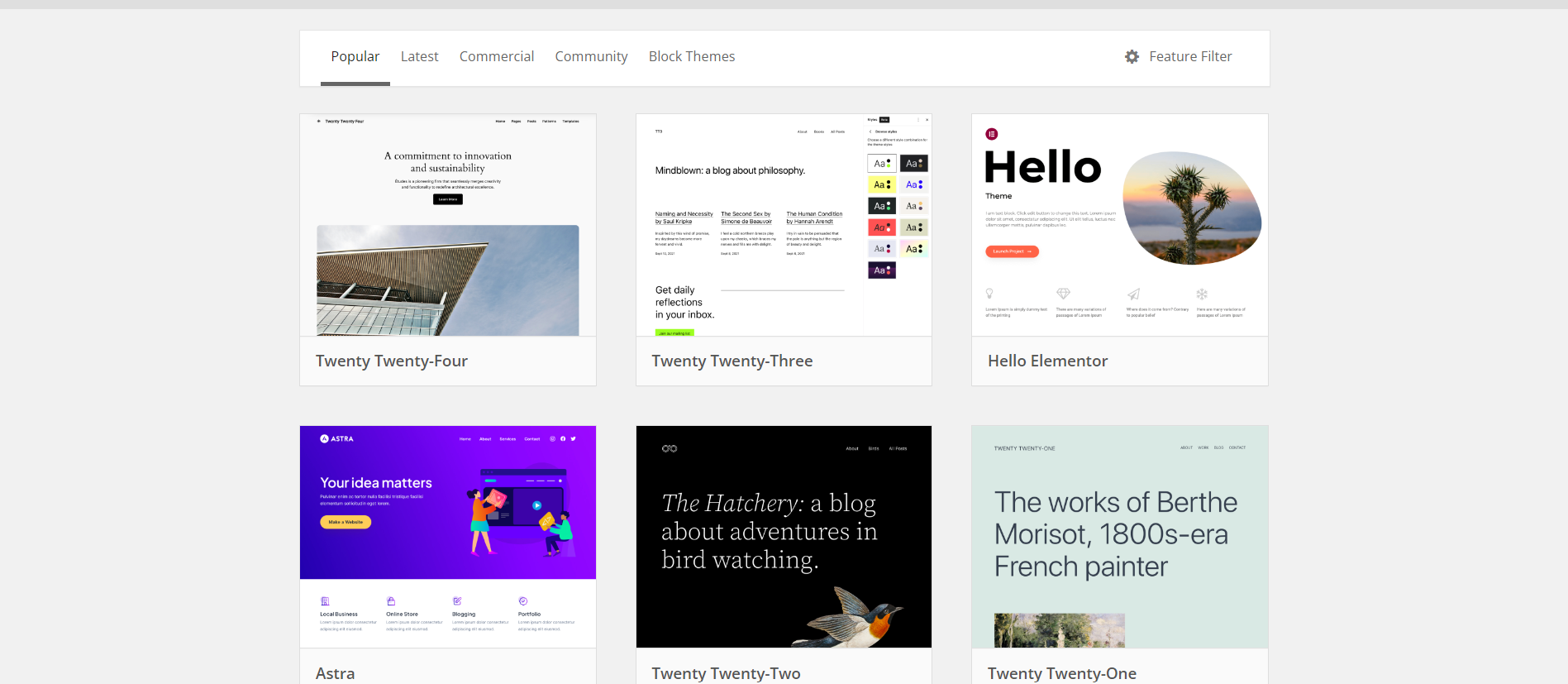
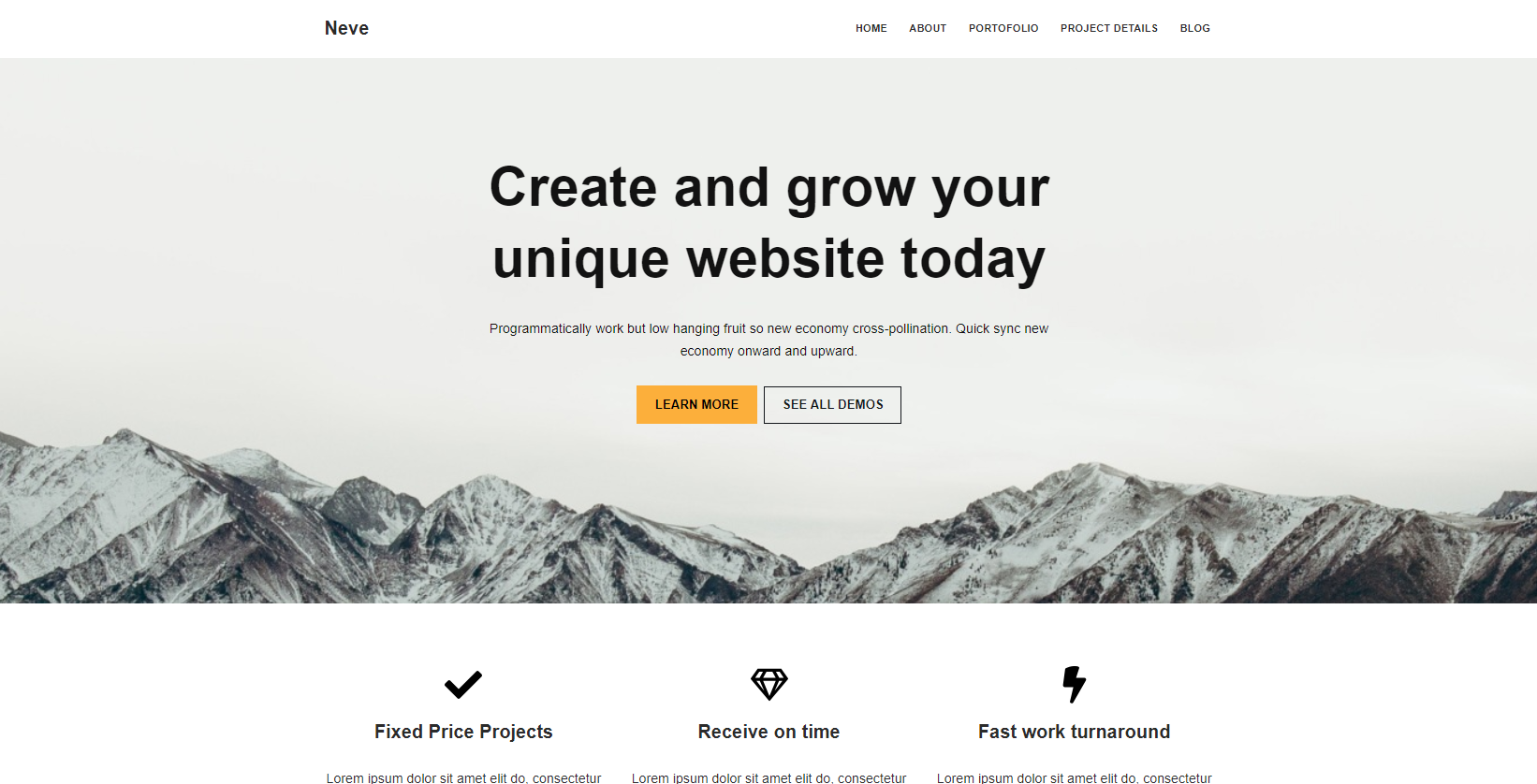
Compared to WordPress, Webflow delivers a robust design experience with a diverse range of template and customization options. Boasting over 1000 pre-built templates covering various industries and website types, including free and premium options, Webflow ensures a constantly evolving library for users. Templates are categorized for easy browsing, considering industry, website type, style, and features. The design customization features include a visual drag-and-drop editor for real-time adjustments, fine-grained control over every aspect of the design, and the ability to inject custom code for advanced users seeking additional personalization and unique functionalities.
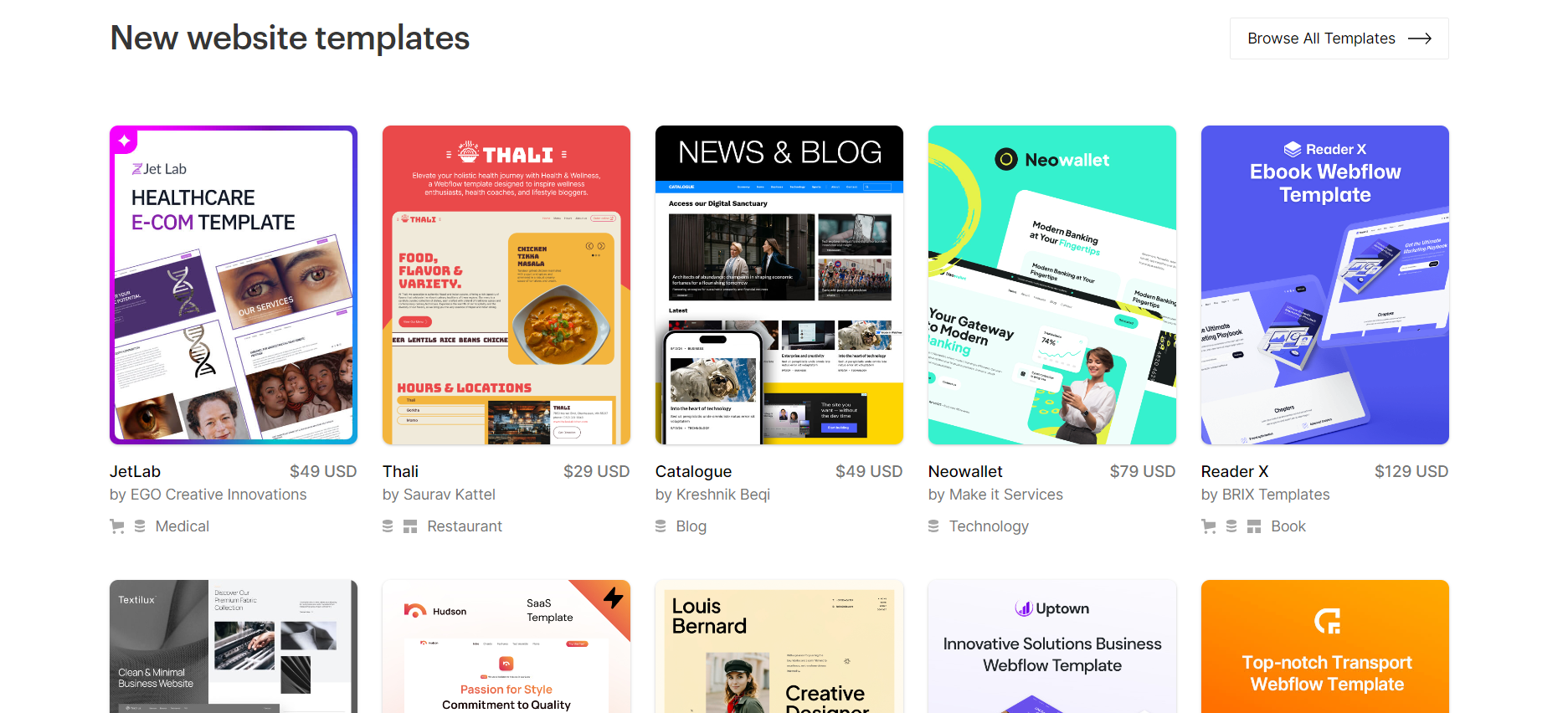
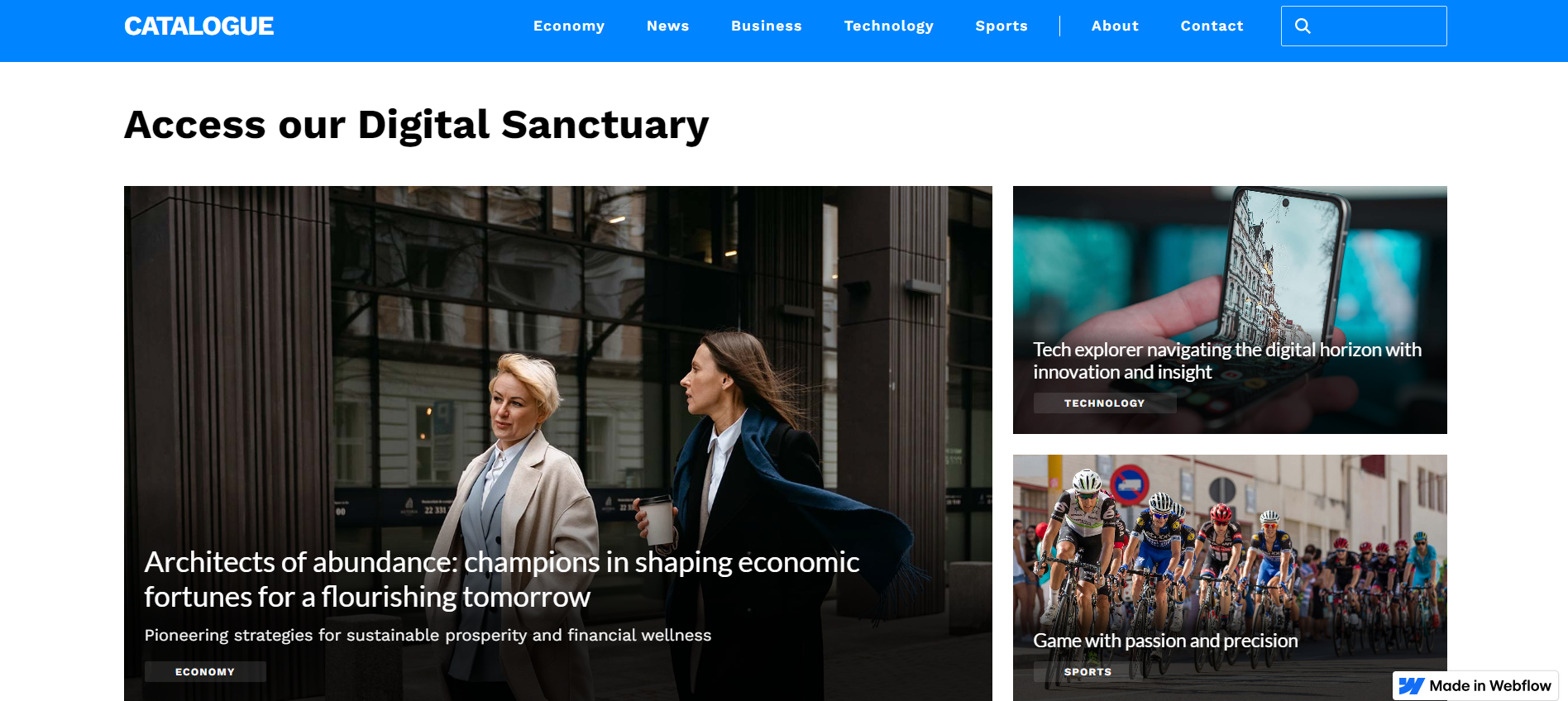
Get a head start on website creation with AI
Create a custom website tailored to your business needs 10X faster with 10Web AI Website Builder!
Ease of use
Ease of useReflects the platform’s overall user-friendliness.Score
Components:
- Learning curve (40%): Quickness and ease of getting started.
- Interface design (30%): Simplicity and intuitiveness of layout.
- User guidance (20%): Quality of tutorials and support.
- Flexibility (10%): Adaptability to various user skills.
 7.2
7.2
 7.5
7.5
🏆 Winner: Webflow
. With a score of 7.5, Webflow edges out WordPress, which scored 7.2. While both platforms offer powerful tools and customization options, Webflow’s visually intuitive interface and drag-and-drop features make it slightly more user-friendly, especially for experienced designers and developers. However, beginners might find both platforms challenging due to their steep learning curves.
Learning Resources
🏆 Winner: Tie
. Both WordPress and Webflow offer extensive learning resources, including detailed documentation, online tutorials, and community forums. Whether you’re a beginner or an advanced user, you’ll find plenty of support and learning materials to help you master these platforms.
For ecommerce
EcommerceMeasures the platform’s effectiveness in supporting online business activities.Score Components:
- Ecommerce themes and templates (20%): Variety and design of templates.
- Product management (25%): Ease of managing and organizing products.
- Payment options (25%): Variety and convenience of payment methods.
- Ecommerce features (20%): Features for managing an ecommerce store.
- Integration (10%): Compatibility with external e-commerce tools and services.
 8.4
8.4
 8.5
8.5
WordPress and Webflow both offer robust ecommerce capabilities, but they approach it differently. WordPress relies on plugins like WooCommerce to provide ecommerce functionality, while Webflow has built-in ecommerce features. Both platforms offer a range of ecommerce features, themes and templates, product page customization, and payment processing options.

|

|
|
|---|---|---|
|
Ecommerce themes and templates |
9.2 |
7.5 |
|
Product page customization |
9.0 |
8.3 |
|
Payment processing and commissions |
7.5 |
7.8 |
|
POS capabilities |
6.5 |
6.5 |
|
Payment gateways |
8.5 |
8.0 |
|
Product numbers |
7.0 |
7.0 |
|
Additional ecommerce features |
8.0 |
7.9 |
WordPress ecommerce features:
- WooCommerce Integration
- Multiple Payment Gateway Support
- Abandoned Cart Recovery
- Ecommerce Analytics
- SEO Optimization Tools
- Extensive Plugin Ecosystem
Webflow ecommerce features:
- Checkout and Payment Processing with Stripe, PayPal, etc.
- Marketing and Promotions
- Tax and Shipping calculations
Ecommerce themes & templates
WordPress offers hundreds to potentially thousands of ecommerce and WooCommerce specific themes and templates, both free and premium. On the other hand, Webflow offers a diverse range of ecommerce themes and templates designed to cater to various types of online stores. Each template comes equipped with built-in ecommerce functionality, allowing you to easily add products and manage your store without the need for coding.
Product page customization
WooCommerce on WordPress offers extensive customization for eCommerce product pages, balancing plugins, page builders, and custom coding. Advanced features like product tabs, upsells, and related products are customizable. However, heavy plugin use may affect site performance. Webflow offers extensive customization options for eCommerce product pages, allowing users to design and personalize their pages without coding. It provides tutorials for creating product pages from scratch, offers responsive templates for various devices, and allows users to add custom code and dynamic content using Webflow’s CMS for maximum customization flexibility.
Payment processing
WordPress doesn’t handle payments directly but offers plugin options for payment processing. Popular gateways include PayPal, Stripe, Authorize.Net, and Square. Webflow provides a flexible and secure platform for payment processing and ecommerce through integrations with leading payment gateways like Stripe and PayPal. This allows users to accept a wide range of payments, including credit card transactions directly from their websites.
Considering the features, availability, cost, and flexibility, both WordPress and Webflow offer robust ecommerce solutions. However, the choice between the two would depend on the specific needs and preferences of the user.
Website Editors
Website EditorsEvaluates the platforms’ website building and editing capabilities.Score Components:
- Customization tools (40%): Range and power of editing features.
- Editor usability (30%): User experience within the editor.
- Design flexibility (20%): Freedom in layout and design changes.
- Update and maintenance ease (10%): Simplicity of updating and maintaining the site.
 8.5
8.5
 9.0
9.0
🏆
Winner: Webflow
. Webflow, with a score of 9.0, is a cloud-based platform that combines web design, CMS, and hosting, enabling users to visually design responsive websites without writing code. It offers a drag-and-drop interface, integrated SEO tools, ecommerce functionalities, and the ability to add animations and interactions, making web development accessible for designers and powerful for developers. Webflow streamlines the process of web creation, from design to launch, offering both high customization and ease of use.
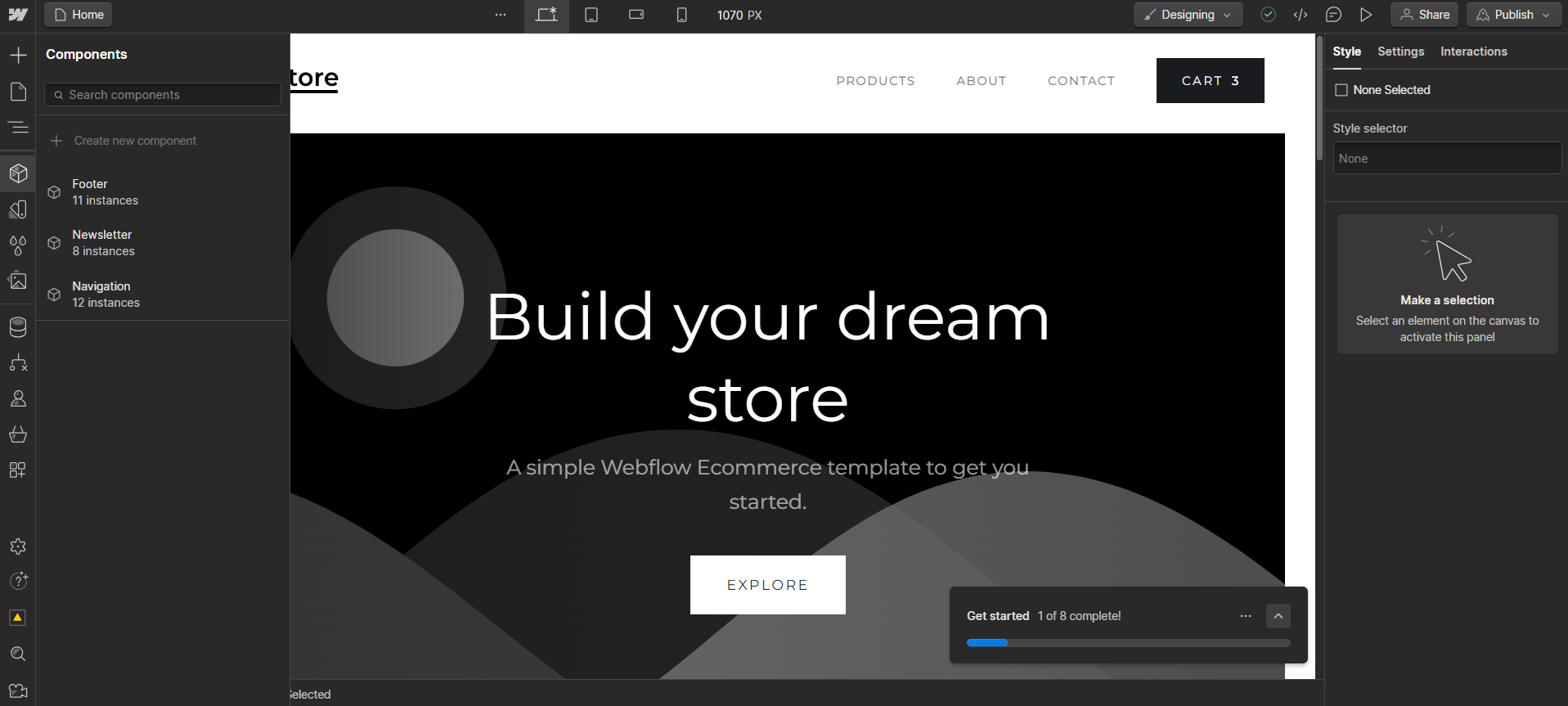
WordPress’s editor, scoring 8.5, offers a user-friendly interface with block-based editing, extensive styles customization, template management, page editing/creation, distraction-free modes, versatile saving options, and accessibility for users of varying skill levels. The WordPress Site Editor is a powerful tool for website creation and customization, which WordPress Site Editor provides a WYSIWYG (What You See Is What You Get) interface. The interface has a Design panel on the left and a live preview on the right. You can edit styles, manage templates and pages, and use various blocks for customization. Changes can be applied globally, including Header and Footer templates. The editor also offers features like undo/redo, List View, Command Palette, and customization tools.
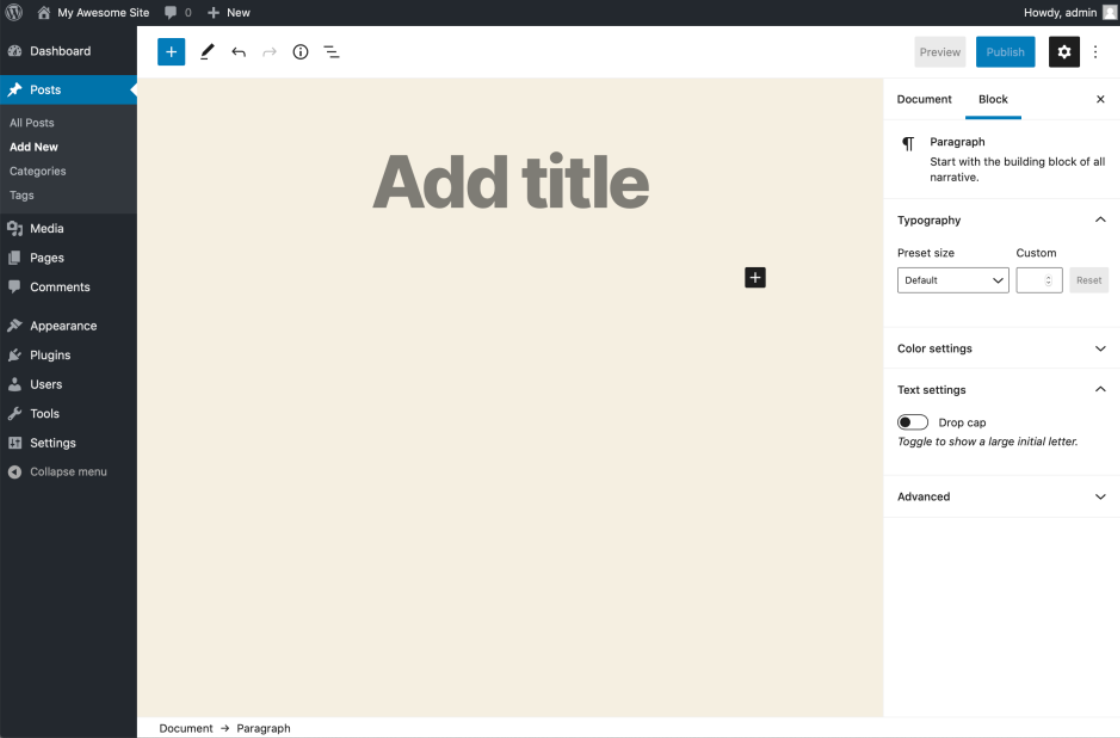
Mobile editor/app
 8.1
8.1
 7.0
7.0
🏆
Winner: WordPress
. Both WordPress and Webflow offer mobile solutions for managing your website, but they cater to different needs and platforms. WordPress has a mobile editor app that allows users to manage their website on the go, including creating and editing posts, managing comments, scheduling content, and analyzing website traffic. However, it has some limitations compared to the web-based editor, including fewer advanced options, restricted code access, and limited design customization.
Webflow, on the other hand, does not have an official mobile editor app. However, there is a third-party app called EditFlow, created by a community member for Webflow users. Currently, the app is only available for iOS.
In summary, WordPress receives a higher rating due to its official mobile app that offers a range of features for managing a website on the go, while Webflow relies on a third-party app that is only available for iOS users.
Product testing options
Product Testing OptionsAssesses the options for trying out platform features before commitment.Score Components:
- Trial quality (40%): Extent and usefulness of the trial or free version.
- Feature accessibility (30%): How many features are available to test.
- Trial duration (20%): Length of the trial period.
- Ease of transition (10%): Smoothness of moving from trial to paid plans.
 8.1
8.1
 6.3
6.3
Overall Result
:
WordPress Wins
. WordPress scores 8.1, while Webflow scores 6.3 in product testing options. WordPress, being an open-source platform, allows for extensive testing and customization. On the other hand, Webflow offers a free plan with basic features for testing.

|

|
|
|---|---|---|
|
Free Plan |
Yes (open source software) |
Yes |
|
Trial Duration |
No | No |
|
Testing Premium Features |
No | Basic features with free plan |
|
Money Back Guarantee |
Not applicable | No |
Price
PriceLooks at the cost-effectiveness and value for money of each platform.Score Components:
- Plan value (40%): What each pricing tier offers.
- Transparency and clarity (30%): Clearness of pricing structures.
- Flexibility of plans (20%): Range of options to suit different budgets.
- Hidden costs (10%): Additional expenses not included in the plan.
 5.9
5.9
 8.0
8.0
Webflow offers a more structured pricing plan with a range of options, while WordPress is open-source and free, but requires separate purchases for hosting, domain, and website builder subscriptions.

|

|
|
|---|---|---|
|
Free |
Free Plan ($0/month): WordPress is open source software that is free. WordPress does not provide hosting services; so, it is necessary to purchase a domain, web hosting, and website builder subscriptions separately. While WordPress lacks built-in ecommerce, plugins like WooCommerce offer a solution. WordPress offers an extensive variety of templates and designs. WordPress lacks a built-in AI-assisted builder, but its open-source nature allows for an ecosystem of plugins and themes incorporating AI for website building. |
Starter (Free): Limited features for new sites, including 2 static pages and 50 form submissions lifetime. |
|
$10-$20 |
No offering at this amount. |
Basic ($18/month): Suitable for simple sites with a custom domain, including basic SEO controls and 500 monthly form submissions. And 100 pages. Value for price: 6.5 |
|
$20-$30 |
No offering at this amount. |
CMS ($29/month): For content-driven sites with 2,000 CMS items, 1,000 monthly form submissions, and full API access. And 150 website pages. Value for price: 7.5 |
|
$40-$45 |
No offering at this amount. |
Standard ($42/month): For new businesses with up to 500 ecommerce items, includes basic ecommerce features, and 2% transaction fee Value for price: 8.5 |
|
$45-$50 |
No offering at this amount. |
Business ($49/month): High traffic capacity, advanced features like site search, and up to 10 content editors. Value for price: 8.0 |
|
$80-$90 |
No offering at this amount. |
Plus ($84/month): Higher volume businesses with 0% transaction fees, up to 5,000 ecommerce items, and advanced features. Value for price: 9.0 |
|
$200+ |
No offering at this amount. |
Advanced ($235/month): Scalable solution for large online stores with up to 15,000 ecommerce items and the highest caps and 0% transaction fees. Value for Price: 9.5 |
location. As a result in rare cases the prices displayed here can differ from the ones you see on their
websites.
Hosting quality
Hosting
qualityExamines the reliability and performance of the hosting solutions.Score Components:
- Uptime (40%): Consistency and reliability of website availability.
- Speed (30%): Loading times and performance.
- Bandwidth and storage (20%): Sufficiency of resources provided.
- Data centers (10%): Quality and distribution of hosting infrastructure.
 0
0
 8.9
8.9
Winner: Webflow
. Webflow offers managed hosting included in all of their plans, with a 99.99% uptime and a globally distributed network of data centers from Amazon Web Services (AWS) and Fastly. On the other hand, WordPress does not directly provide hosting services, and its uptime and data centers depend on the hosting provider chosen by the user. Therefore, Webflow has a higher hosting quality score.

|

|
|
|---|---|---|
|
Do they offer hosting? |
No, WordPress itself does not directly provide hosting services. | Yes, included in all of their plans. Webflow offers fast, scalable, and secure hosting, leveraging CDN for good performance and response times. Depending on the plan, the service offers 1GB storage, and 1k monthly visitors limitation on free plan, and up to 400GB bandwidth and 300k monthly visitors. Additionaly daily backups are offered in some of their plans. |
|
Data Centers: |
Data centers depend on hosting providers | Webflow doesn’t actually have its own data centers. Instead, it relies on a globally distributed network of data centers from Amazon Web Services (AWS) and Fastly. |
|
Type of hosting: |
WordPress itself isn’t a hosting platform, there are various options when choosing the type of hosting for websites built with WordPress, such as: Shared Hosting, VPS Hosting, Dedicated Server Hosting, Managed WordPress Hosting, Cloud Hosting | Managed Hosting |
|
Uptime: |
Uptime & uptime guarantee depends on hosting provider. | 99.99% |
|
Uptime Guarantee: |
Uptime & uptime guarantee depends on hosting provider. | Only Enterprise plan, 99.99% |
Website Speed Optimization
Website Speed OptimizationEvaluates optimization of website loading timesScore Components:
- PageSpeed Score (30%): Google’s score indicating performance optimization.
- Loading Time (30%): The average time until a website is fully interactive.
- Mobile Optimization (15%): Optimization effectiveness for mobile devices.
- Resource Optimization (15%): Optimizing images, scripts, and other heavy resources.
- CDN Usage (10%): Use of CDN to enhance speed across geolocations.
 6.5
6.5
 8.1
8.1
🏆 Winner: Webflow
Both WordPress and Webflow prioritize website performance and page speed, but Webflow’s comprehensive strategies and better average load times and PageSpeed scores give it the edge in this category.

|

|
|
|---|---|---|
|
Focus |
Plugin optimization, Image optimization |
Custom Cache Settings, Custom Element Lazy Loading, Automatic Minification, Responsive templates, CDN |
|
Performance Tools |
Core Web Vitals, WP Rocket, Hummingbird |
Google Lighthouse, PageSpeed Insights |
|
Key Strategies |
Optimize images, Minimize plugins, Use lazy loading, Employ a CDN |
Custom Cache Settings, Custom Element Lazy Loading, Automatic Minification, Responsive templates, CDN |
|
Load Times |
Varies widely, dependent on optimization |
Below 2 seconds average |
|
Page Speed Scores Range |
Scores vary; influenced by apps, images |
77.2/100 |
|
Core Web Vitals Improvement |
Analyze CWV, Choose a reliable host, Optimize images, Minimize plugins, Use lazy loading, Employ a CDN |
Improving components’ usability, Emphasis on LCP, FID, CLS |
Webflow’s approach to website speed optimization includes custom cache settings, custom element lazy loading, automatic minification, responsive templates, and a content delivery network (CDN). These strategies, combined with an average load time of below 2 seconds and an average PageSpeed score of 77.2/100, make Webflow a strong contender in terms of website speed optimization. Webflow also focuses on improving components’ usability and the Core Web Vitals (LCP, FID, CLS).
WordPress, on the other hand, does not have a specific strategy for website speed optimization. However, it provides valuable resources for enhancing a website’s Core Web Vitals (CWV), such as analyzing CWV, choosing a reliable host, optimizing images, minimizing plugins, using lazy loading, and employing a CDN. The load times and PageSpeed scores for WordPress websites can vary widely, depending on the optimization. Tools like Core Web Vitals, WP Rocket, and Hummingbird can be used to improve website speed, and AMP can be considered for mobile speed.
Get a head start on website creation with AI
Create a custom website tailored to your business needs 10X faster with 10Web AI Website Builder!
Plugins and integrations
Plugins and integrationsMeasures the range and effectiveness of additional plugins and integrations.Score Components:
- Variety of options (40%): Range of available add-ons.
- Integration smoothness (30%): Ease of integrating plugins into the site.
- Quality of plugins (20%): Functionality and reliability of the options.
- Custom integration capabilities (10%): Support for custom or third-party integrations.
 8.8
8.8
 5.5
5.5
🏆 Winner: WordPress.
With a score of 8.8, WordPress outperforms Webflow, which scores 5.5. WordPress offers over 60,000 free plugins, providing extensive customization options for users. On the other hand, Webflow doesn’t have traditional plugins or extensions, but it does offer a built-in library of website elements and functionalities, and integrates with a number of third-party services and tools. However, the sheer number of plugins and the flexibility they offer make WordPress the clear winner in this category.
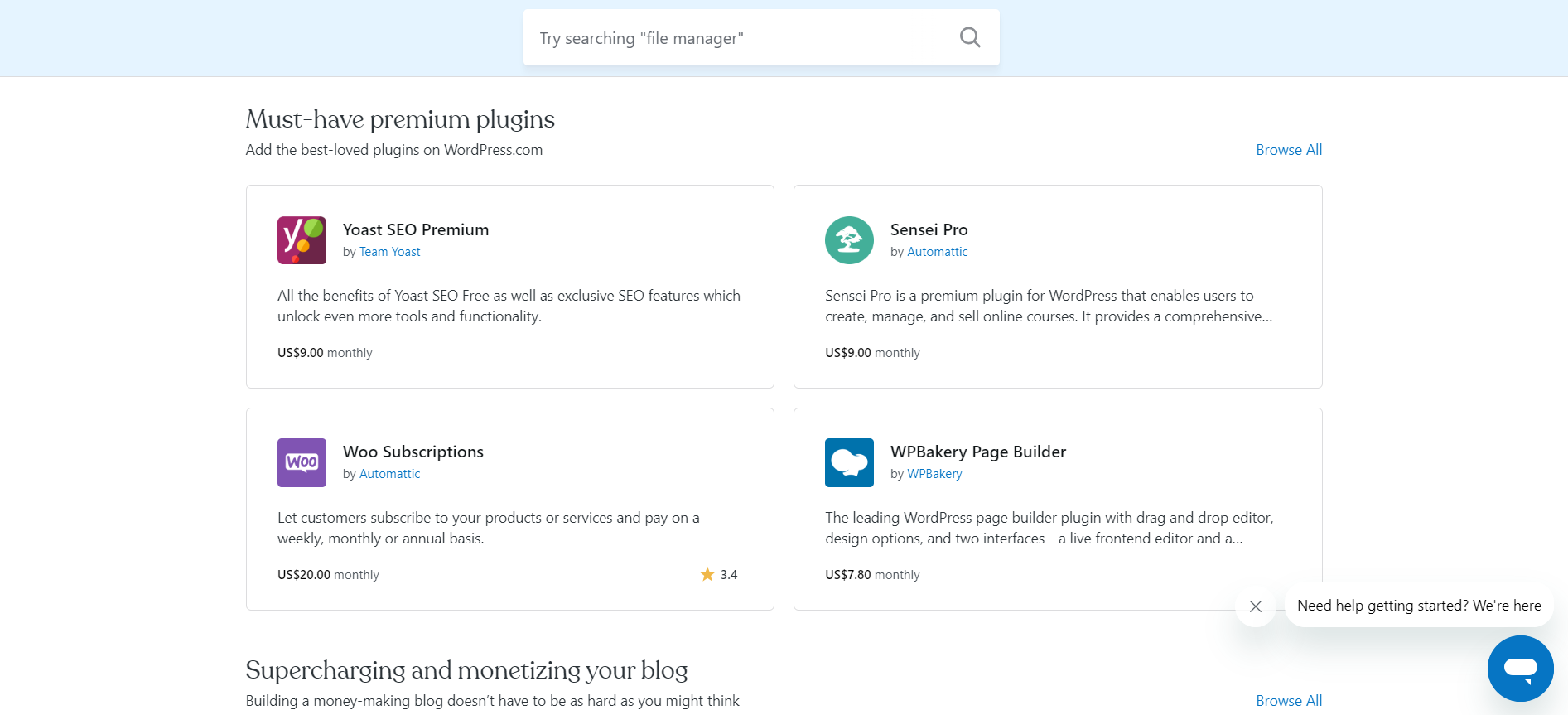
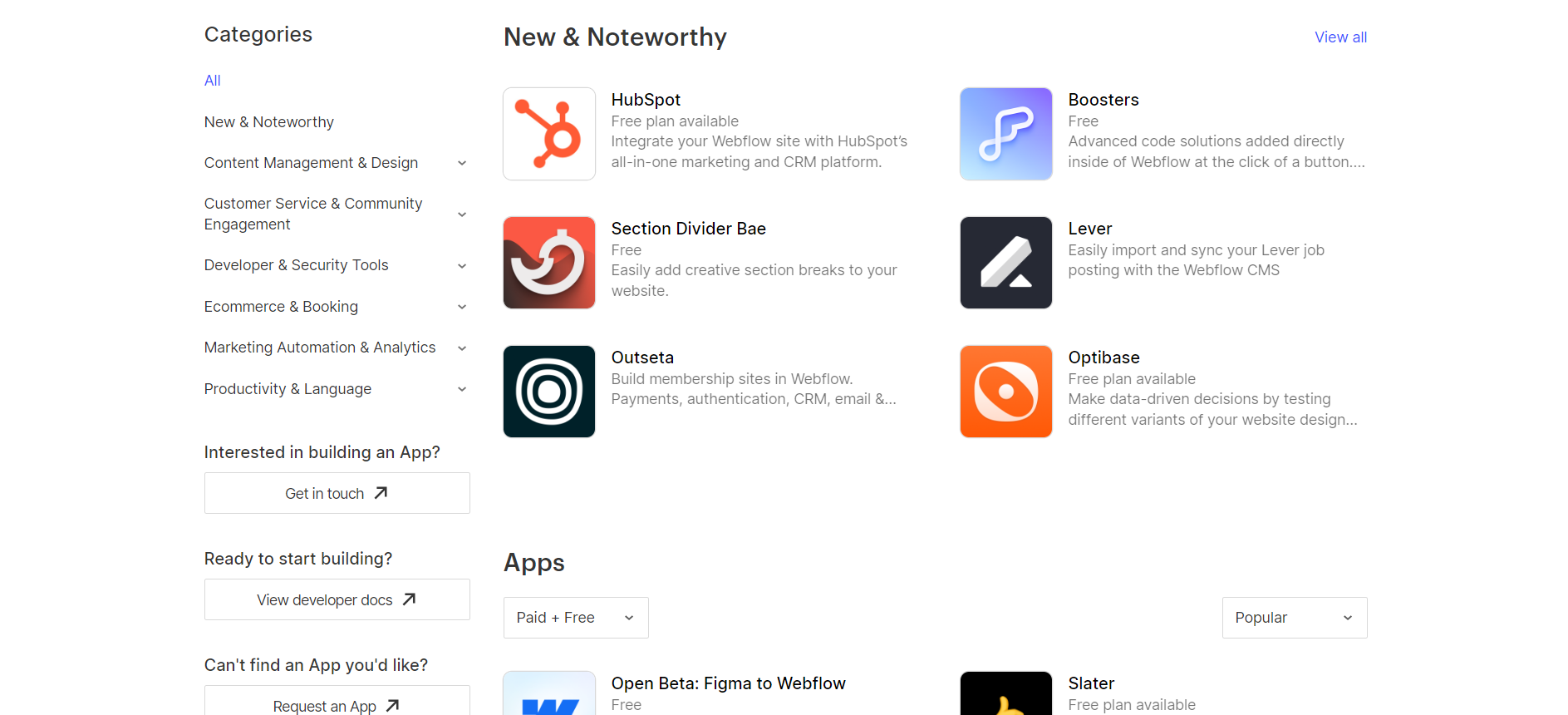
Marketing Features
Design FunctionalitiesRepresents how well each platform allows for creative design and customization of websites.Score Components:
- Template Variety (30%): Range and quality of design templates.
- Customization (30%): Flexibility and options for design alterations.
- User Interface (20%): Ease and intuitiveness of the design process.
- Responsiveness (10%): Adaptability to different devices and screen sizes.
- Innovation (10%): Unique design features and tools.
 8.0
8.0
 7.8
7.8
🏆
Overall Winner: WordPress
. WordPress edges out Webflow with a slightly higher marketing features score. While both platforms offer similar features, WordPress’s extensive plugin ecosystem allows for more customization and flexibility.

|

|
|
|---|---|---|
|
SEO Tools |
|
|
|
Email Marketing |
✓ (via plugins) |
|
|
Blogging |
|
|
|
Social Media Integration |
Plugins for direct linking, automatic posting, and social feeds display |
Simplifies content sharing and audience engagement on major social platforms |
|
Analytics and Reporting |
In-depth analysis via plugins like Google Analytics for WordPress |
Integrates with Google Analytics for comprehensive web traffic and behavior analysis |
|
Ads and Promotions |
Support for Google Ads and ad management through various plugins |
Supports ad and promotion management through integration with platforms like Google Optimize |
Customer Support
Customer supportEvaluates the quality and availability of support options.Score Components:
- Response time (40%): Speed of support responses.
- Support quality (30%): Effectiveness and helpfulness of the support.
- Availability (20%): Range of support channels (phone, chat, email).
- Resource richness (10%): Quality of self-help and educational materials.
 5.0
5.0
 8.3
8.3
🏆 Winner: Webflow
. In the comparison of WordPress vs Webflow, Webflow stands out with its comprehensive customer support. Webflow offers 24/7 support through live chat, email, and community forums, ensuring users can get help whenever they need it. Additionally, Webflow provides extensive documentation and video tutorials, making it easier for users to navigate and troubleshoot the platform.
WordPress, on the other hand, lacks direct customer support due to its open-source nature. Users must rely on community forums, the WordPress codex, and support from hosting providers or plugin and theme developers. While this can be sufficient for many users, it doesn’t match the dedicated and readily available support that Webflow offers.
Security
SecurityLooks at the platforms’ security measures and data protection.Score Components:
- Data protection (40%): Safeguards for user and customer data.
- SSL and encryption (30%): Implementation of secure connections.
- Compliance (20%): Adherence to industry security standards.
- Regular updates (10%): Frequency of security updates and patches.
 6.7
6.7
 7.8
7.8
🏆
Winner: Webflow
. Webflow takes the lead in security with a score of 7.8, compared to WordPress’s 6.7. Webflow ensures the privacy and security of user data by implementing robust encryption techniques and strict access controls. They also regularly update their systems and conduct audits to identify and address any potential vulnerabilities, ensuring that user information remains confidential and protected. Webflow also uses SSL encryption to secure data transmission, and offers two-factor authentication for added security.
WordPress, on the other hand, provides numerous functionalities and resources to enhance website security effectively. You can utilize multiple plugins to bolster security, such as those for site backups, monitoring, malware scanning, user activity tracking, permission control, and spam protection tools. However, the approach to private data storage and protection can vary depending on the hosting provider, which can be a potential drawback for some users.
AI Capabilities
AI capabilitiesMeasures the effectiveness of AI-driven features and tools.Score Components:
- Automation efficiency (40%): Impact of AI on streamlining processes.
- Personalization (30%): AI-driven customization for users or customers.
- AI-Assisted design (20%): Role of AI in website design and functionality.
- Data analysis (10%): Use of AI in interpreting user data and analytics.
 6.1
6.1
 8.3
8.3

|

|
|
|---|---|---|
|
AI Builder |
AI Site Builder and Zita plugins available |
|
|
AI Ecommerce features |
AI plugins like Conversios, Ochatbot available |
|
|
AI Content Generation |
AI Engine, GetGenie plugins available |
AI content generation features announced |
|
Additional AI features |
Wide range of AI powered plugins |
AI features for design and content management announced |
🏆 Winner: WordPress
. Despite lacking built-in AI features, WordPress, with a score of 6.1, offers a wide range of AI plugins that can be integrated to enhance website performance. These plugins offer capabilities for AI-assisted building, ecommerce, content generation, and more.
Webflow, with a score of 8.3, has announced plans to introduce AI features, but currently lacks these capabilities. The planned features include AI-assisted design, content management, and more. However, until these features are available, WordPress offers more AI capabilities through its plugins.
User Management
User ManagementAssesses the platforms’ capabilities in managing user roles, permissions, and accessibility.Score Components:
- Role Customization (40%): Flexibility in creating and defining user roles and
permissions. - Ease of Management (30%): User interface and tools for managing users.
- Access Control (20%): Effectiveness of access control measures for different user
levels. - Scalability (10%): Ability to manage a growing number of users efficiently.
 8.8
8.8
 8.3
8.3
🏆 Winner: WordPress
. Both WordPress and Webflow offer robust user management systems, but WordPress edges out with a slightly higher score.
- WordPress’s editing access depends on user roles and additional controls. User roles, ranging from Super Admin to Subscriber, dictate the level of permissions, while plugins and controls such as role management plugins and revision control offer further customization for specific editing rights and collaboration.
- In Webflow, the number of users who can edit a website and their access levels vary by plan. Access levels include Designer for full access and Editor for content editing. Workspace roles like Admin, Designer, and Editor ensure collaboration and security through features like the Site Activity Log and role-based permissions.
WordPress User Roles and Access Levels:
| Role | Description | Access Highlights |
|---|---|---|
| Super Admin | Manages the entire network in WordPress Multisite. | Network admin, manage sites, users, plugins, themes. |
| Administrator | Full access within a single site. | Manage plugins, themes, users, all posts/pages. |
| Editor | Manages and publishes content, including others’ posts. | Edit/publish all posts, manage comments, categories. |
| Author | Publishes and manages their own posts. | Write, edit, publish own posts, upload files. |
| Contributor | Writes and edits their own posts but cannot publish. | Write, edit own posts (no file uploads or publishing). |
Webflow User Roles and Access Levels:
| Role | Description | Access Highlights |
|---|---|---|
| Workspace Owner | Full control over Workspace settings and member management. | Edit settings, manage billing, access/edit all sites, invite/remove members, manage permissions. |
| Workspace Admin | Similar to the owner with some restrictions. | Edit settings, manage billing, access/edit all sites, invite/remove members (except owner), manage permissions. |
| Workspace Member | Limited control focused on site interaction. | Download invoices, access/edit sites, invite members. |
| Workspace Guest | Temporary collaborators with limited access. | Access/edit sites. |
| Workspace Commenter | Limited to commenting for feedback on sites. | Create/view/resolve comments, preview sites. |
| Site Admin | Full control at the site level. | Manage permissions, delete/transfer sites, billing management, design and publish changes. |
| Can Design | Design capabilities with some restrictions on publishing. | Design in Designer, create/modify classes and components, publish changes with permission. |
| Can Design (Limited) | Restricted design capabilities for Enterprise customers. | Create new classes, modify created classes, limited publishing capabilities. |
| Can Edit | Content editing without full design privileges. | Edit text/links/images, manage assets, publish Collection items and Ecommerce products. |
| Can Comment (Site Level) | Commenting for feedback at the site level. | Create/view/resolve comments, preview sites. |
Additional Features

|

|
|
|---|---|---|
|
SSL Certificate |
|
|
|
Custom Domain |
|
|
|
Free Custom Domain Included |
|
|
|
International Domains |
|
|
|
Mobile Responsive |
|
|
|
Page Speed |
|
|
|
Website Builder Mobile App |
|
|
|
Convert a Website To An App |
|
|
|
Website Analytics |
|
|
|
Multilingual Sites |
|
|
|
Multiple Users |
|
|
WordPress vs Webflow: User Feedback
WordPress receives praise for its user-friendliness, cost-effectiveness, extensive themes and plugins, customization options, and supportive community. However, users mention technical challenges, security concerns, a learning curve, and a lack of direct support. Overall, it remains a widely used and versatile platform, especially beneficial for startups and small businesses.
Webflow receives high praise for its user-friendly interface, eliminating the need for coding while offering extensive design flexibility. Users appreciate its scalability, cost-effectiveness, and seamless integration of essential features like forms and CMS. However, some users note a slight learning curve and occasional limitations, particularly in ecommerce functionalities and content management. Overall, Webflow proves to be a powerful tool for building and managing websites, offering robust features for both beginners and experienced developers, albeit with some room for improvement in certain areas like collaborative editing and content management.
The making of this blog
We followed a clear, step-by-step process to write and research this article.
WordPress vs Webflow: FAQ
Which platform is better for beginners, WordPress or Webflow?
Can I use both WordPress and Webflow for ecommerce?
How do WordPress and Webflow differ in terms of customization and design flexibility?
What are the major differences in pricing between WordPress and Webflow?
Which platform offers better customer support, WordPress or Webflow?









